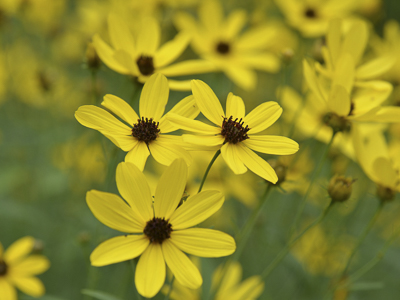

Exceptional native plants for beautiful gardens that support wildlilfe.

Mt. Cuba Center is a botanic garden that highlights the beauty and value of native plants to inspire conservation. Once the private estate of Pamela and Lammot du Pont Copeland, the public garden opened for general admission in 2013 and now spans more than 1,000 acres. It features captivating blooms along garden pathways in formal and woodland settings, picturesque meadows and ponds with stunning vistas, and more than two miles of scenic trails throughout its natural lands. Mt. Cuba is recognized as a leader in native plant research and open space preservation, having protected more than 13,000 acres in the mid-Atlantic region. In 2021, it was voted one of the top five best botanical gardens in North America by USA Today readers. Additionally, it was awarded The News Journal’s Top Workplaces 2021 and Delaware Today’s Best of Delaware for “Best Place to Experience Nature” and “Best Workshops” for its gardening, conservation, art, and wellness classes. Learn more at mtcubacenter.org.

The Mt. Cuba Collection™ features a selection of exceptional native plants that provide stunning seasonal interest while welcoming wildlife into your garden. Selected for strong ornamental appeal and broad regional adaptability, many members of this collection have risen to become some of the most popular cultivars of native plants available.
The Mt. Cuba Collection™ is now available as plugs in full flats to customers outside of the trade exclusively through Izel Plants. We will donate $15.00 to Mt. Cuba Center in support of their mission for each flat ordered.
Iris versicolor ‘Purple Flame’
Purple Flame blue flag

Iris versicolor ‘Purple Flame’, or Purple Flame blue flag, is an exciting new selection of Iris versicolor that has grown in our gardens for decades.
While it is similar in many ways to the typical native blue flag, Iris versicolor ‘Purple Flame’ sets itself apart when the eye-catching eggplant-purple foliage emerges in early spring. As the season progresses, Purple Flame blue flag produces dark stems that display 3-4” showy, purple flowers with a splash of yellow color above the 2-3’ tall foliage. As the blooms begin in late May, leaves fade to more subdued tones of green.
Iris versicolor ‘Purple Flame’ grows well in wet-to-average soil in filtered shade and full sun. It is hardy from zone 3 to 9. Introduced in 2020.
Coreopsis tripteris ‘Gold Standard
Gold Standard tall tickseed

Coreopsis tripteris ‘Gold Standard’ is an incredibly sturdy and floriferous selection of Coreopsis tripteris. Commonly referred to as Gold Standard tall tickseed, the mature height of Coreopsis tripteris ‘Gold Standard’ is approximately 5-6′ tall, which is slightly shorter than the typical tall tickseed. Beginning in late July, a multitude of sunshine yellow flowers appear above the robust, disease-resistant foliage. The floral display lasts for more than two months and the resulting seeds are a favorite among goldfinches. Coreopsis tripteris ‘Gold Standard’ is a rhizomatous cultivar that spreads slowly—approximately 2′ over three years. This plant was collected from Jefferson County, Alabama, and was named and introduced as a result of its excellent performance in Mt. Cuba Center’s coreopsis trial. Introduced in 2016.
Solidago sphacelata ‘Golden Fleece’
Golden Fleece autumn goldenrod

Solidago sphacelata ‘Golden Fleece’, or Golden Fleece autumn goldenrod, was discovered in 1985 as a spontaneous garden seedling in Eden, North Carolina. It was evaluated under diverse conditions at Mt. Cuba Center and determined to be a low-growing, compact form of the species. Growing only 18″ tall, it is suitable for use as an herbaceous perennial groundcover. Multi-branched stems arise from basal rosettes of broadly rounded foliage and are covered with a profusion of golden-yellow floral spires from mid-September to October.
It performs best in full sun with average moisture but is tolerant of a range of conditions from sunny and dry to partial shade. Solidago sphacelata ‘Golden Fleece’ is hardy in zones 3-8. It won the Internationale Stauden-Union’s Award for an outstanding new plant in Switzerland in 1994. Introduced in 1989.
Symphyotrichum laeve var. laeve ‘Bluebird’
Bluebird smooth aster

Formerly called Aster laevis, Symphyotrichum laeve var. laeve ‘Bluebird’, or Bluebird smooth aster, is an herbaceous perennial, selected for its attractive, pest-free foliage and large (1”), violet-blue flowers.
It was found in 1988 in a Guilford, Connecticut, garden as a spontaneously occurring seedling. It has an upright habit to 4’ tall and generally needs no staking.
Symphyotrichum laeve var. laeve ‘Bluebird’ blooms in September/October in full sun to light shade with a broad tolerance of soil types and moisture levels. Introduced in 1994
Symphyotrichum novae-angliae ‘Purple Dome’
Purple Dome New England aster

Formerly called Aster novae-angliae, Symphyotrichum novae-angliae ‘Purple Dome’, or Purple Dome New England aster, is an herbaceous perennial selected for its compact size, forming a solid purple mound, 18″ tall x 24″ wide, of semi-double flowers in September/October.
Its dense floral display and short stature minimize its lack of resistance to foliar problems. Symphyotrichum novae-angliae ‘Purple Dome’ was first observed along Pennsylvania Route 100 below Allentown, Pennsylvania, by Robert G. Seip of Lennilea Farm and given to Mt. Cuba Center.
It performs best in full sun to light shade in moist, well-drained soil. Introduced in 1989
All photos courtesy of Mt. Cuba Center.
